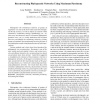Free Online Productivity Tools
i2Speak
i2Symbol
i2OCR
iTex2Img
iWeb2Print
iWeb2Shot
i2Type
iPdf2Split
iPdf2Merge
i2Bopomofo
i2Arabic
i2Style
i2Image
i2PDF
iLatex2Rtf
Sci2ools
CSB
2005
IEEE
2005
IEEE
Reconstructing Phylogenetic Networks Using Maximum Parsimony
Phylogenies—the evolutionary histories of groups of organisms—are one of the most widely used tools throughout the life sciences, as well as objects of research within systematics, evolutionary biology, epidemiology, etc. Almost every tool devised to date to reconstruct phylogenies produces trees; yet it is widely understood and accepted that trees oversimplify the evolutionary histories of many groups of organims, most prominently bacteria (because of horizontal gene transfer) and plants (because of hybrid speciation). Various methods and criteria have been introduced for phylogenetic tree reconstruction. Parsimony is one of the most widely used and studied criteria, and various accurate and efficient heuristics for reconstructing trees based on parsimony have been devised. Jotun Hein suggested a straightforward extension of the parsimony criterion to phylogenetic networks. In this paper we formalize this concept, and provide the first experimental study of the quality of parsi...
| Added | 24 Jun 2010 |
| Updated | 24 Jun 2010 |
| Type | Conference |
| Year | 2005 |
| Where | CSB |
| Authors | Luay Nakhleh, Guohua Jin, Fengmei Zhao, John M. Mellor-Crummey |
Comments (0)

